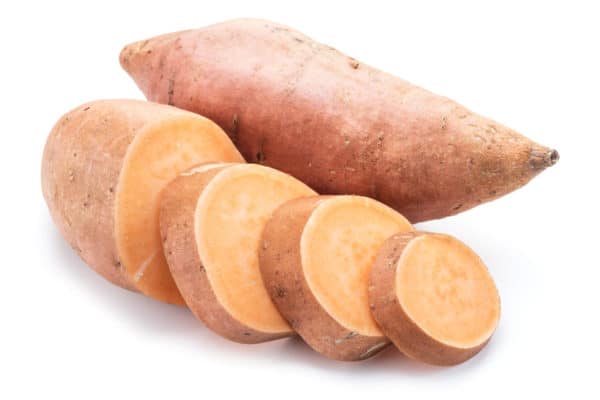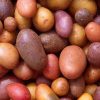Yam or Sweet Potato?

My momma, like so many other Southern homemakers, made wonderful sweet potato pies. So good in fact, that I was in my teens before I knew that her pumpkin pies (one of my favorites) was actually made with sweet potatoes, not pumpkin. Later on for whatever the reason, she actually made pumpkin pies, and they were pretty damn good but I still liked the sweet potato version best.
The one thing my momma did not make was “yam” pies. In fact, I was a young man just entering the culinary world before I heard anyone use the word yam. Perhaps that was because we were pretty much country folks from Southeastern Oklahoma and not too savvy when it came to fancy culinary terms. I distinctly recall the first time I heard the word because the chef I was working under at the time used it when referring to a sweet potato dish we were preparing. That lead to a verbal altercation between him and our well-traveled Spanish sous we called Manny, who told him they were sweet potatoes, not yams. And as it turned out, Manny was right.
Did you know there’s a difference in yams and sweet potatoes? Well, there definitely is.
Yams
As it turns out almost all reddish-orange fleshed tubers eaten in the good ole’ US of A are sweet potatoes—not yams. In fact you nor anyone you know has likely ever seen a yam, much less eaten one.
 Yams are monocots a member of the Dioscoreacea family, closely related to lillies and grasses. They are native primarily to Africa and Asia, although there are a few varieties grown in South America. There are over 600 known yam varieties with 95% of them from Africa. Yam tubers can grow to almost five feet in length and weigh up to 130 pounds. Even the word “yam” derives from the West African word “Unami,” “yam,” or “enzyme,” which means “to eat.”
Yams are monocots a member of the Dioscoreacea family, closely related to lillies and grasses. They are native primarily to Africa and Asia, although there are a few varieties grown in South America. There are over 600 known yam varieties with 95% of them from Africa. Yam tubers can grow to almost five feet in length and weigh up to 130 pounds. Even the word “yam” derives from the West African word “Unami,” “yam,” or “enzyme,” which means “to eat.”
Yams have a thick, rough, scaly skin which is hard to peel. Their skin color may vary from dark brown to light pink. The vegetable’s meat can also vary in color from white to yellow, purple to pink. Yams have a mild earthy taste although drier and starchier than sweet potatoes, whose taste, as the name implies, is much sweeter.
Sweet Potatoes
 The sweet potato on the other hand belongs to the morning glory family, Convolvulacea. And while its large, starchy, sweet tasting tuber is the popular prize, its young leaves and shoots are also edible. The long, tapered root has a smooth skin ranging in color from brown to yellow, to red, white, and purple. Its flesh can also be light beige to yellow, red-orange, orange, and purple, although the orange fleshed varieties Jewel and Beauregard are the most popular in this country.
The sweet potato on the other hand belongs to the morning glory family, Convolvulacea. And while its large, starchy, sweet tasting tuber is the popular prize, its young leaves and shoots are also edible. The long, tapered root has a smooth skin ranging in color from brown to yellow, to red, white, and purple. Its flesh can also be light beige to yellow, red-orange, orange, and purple, although the orange fleshed varieties Jewel and Beauregard are the most popular in this country.
Thought to have originated in Central or South America, the sweet potato was domesticated in the Americas more than 5,000 years ago. In Peru sweet potato remains have been found that date back to 8000 BC.
However, in the 1700s Captain Cook while on his exploration of the Polynesian islands some 4,000 miles from South America discovered sweet potatoes being grown there. Later European explorers also discovered them throughout the Pacific from Hawaii to New Guinea. This brought up a question still unanswered today. How did the sweet potato get from South America to those Pacific islands?
The fact is, sweet potato ranks sixth as the world’s most valuable crops, after rice, wheat, potatoes, maize, and cassava. And it provides more nutrients per acre than any other staple. As it turns out sweet potatoes have helped sustain humans for centuries. There are about 6,500 sweet potato varieties cultivated in almost every major country in the world, including Australia, China, Hawaii, Japan, New Zealand, the Philippines, and of course North and South America. The exception is Europe, which is not a big fan.
And while sweet potatoes are grown mostly for use as food, many people grow them for their beautiful ornamental value.
 But how did the term “yam” become so synonymous with sweet potatoes in this country? Well it seems that a Louisiana researcher by the name of Julian Miller developed a new variety of sweet potato with creamier, less stringy flesh and a more tender skin. It was also higher in vitamin A that traditional sweet potatoes. As a marketing ploy to distinguish their new product, the Louisiana sweet potato industry used the term “yam.” This was undoubtably a successful campaign as the term has stuck in the minds of the American public. So much so that the USDA now requires the words “sweet potatoes” to be incorporated on all domestic yam labels in an effort to clear up the confusion.
But how did the term “yam” become so synonymous with sweet potatoes in this country? Well it seems that a Louisiana researcher by the name of Julian Miller developed a new variety of sweet potato with creamier, less stringy flesh and a more tender skin. It was also higher in vitamin A that traditional sweet potatoes. As a marketing ploy to distinguish their new product, the Louisiana sweet potato industry used the term “yam.” This was undoubtably a successful campaign as the term has stuck in the minds of the American public. So much so that the USDA now requires the words “sweet potatoes” to be incorporated on all domestic yam labels in an effort to clear up the confusion.
Sweet potatoes have been an important part of the U.S. diet from its beginning, especially in the Southeastern part of the country. The per capita consumption of sweet potatoes was about 30 pounds prior to 1920, but due to our societies growing affluence and its connotation as a poor man’s food, consumption has dropped to about 4 pounds today.
In spite of its Latin origin, China is the world’s producer and consumer of the sweet potato, growing about 90 million tons annually. In our country, about 39% of sweet potato production comes from North Carolina, followed by California at 23%, Louisiana at 16% and Mississippi’s 19%.
Now that you know a little about the world of sweet potatoes and how nutritious they are, I hope you’ll enjoy one with your next steak instead of the same ole’ mundane russet potato you normally have.





